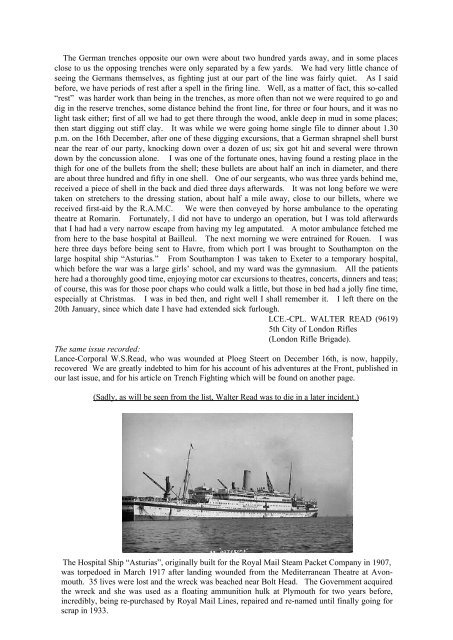World War I Roll of Honour - The Clove Club Hackney Downs School
World War I Roll of Honour - The Clove Club Hackney Downs School
World War I Roll of Honour - The Clove Club Hackney Downs School
Create successful ePaper yourself
Turn your PDF publications into a flip-book with our unique Google optimized e-Paper software.
<strong>The</strong> German trenches opposite our own were about two hundred yards away, and in some places<br />
close to us the opposing trenches were only separated by a few yards. We had very little chance <strong>of</strong><br />
seeing the Germans themselves, as fighting just at our part <strong>of</strong> the line was fairly quiet. As I said<br />
before, we have periods <strong>of</strong> rest after a spell in the firing line. Well, as a matter <strong>of</strong> fact, this so-called<br />
“rest” was harder work than being in the trenches, as more <strong>of</strong>ten than not we were required to go and<br />
dig in the reserve trenches, some distance behind the front line, for three or four hours, and it was no<br />
light task either; first <strong>of</strong> all we had to get there through the wood, ankle deep in mud in some places;<br />
then start digging out stiff clay. It was while we were going home single file to dinner about 1.30<br />
p.m. on the 16th December, after one <strong>of</strong> these digging excursions, that a German shrapnel shell burst<br />
near the rear <strong>of</strong> our party, knocking down over a dozen <strong>of</strong> us; six got hit and several were thrown<br />
down by the concussion alone. I was one <strong>of</strong> the fortunate ones, having found a resting place in the<br />
thigh for one <strong>of</strong> the bullets from the shell; these bullets are about half an inch in diameter, and there<br />
are about three hundred and fifty in one shell. One <strong>of</strong> our sergeants, who was three yards behind me,<br />
received a piece <strong>of</strong> shell in the back and died three days afterwards. It was not long before we were<br />
taken on stretchers to the dressing station, about half a mile away, close to our billets, where we<br />
received first-aid by the R.A.M.C. We were then conveyed by horse ambulance to the operating<br />
theatre at Romarin. Fortunately, I did not have to undergo an operation, but I was told afterwards<br />
that I had had a very narrow escape from having my leg amputated. A motor ambulance fetched me<br />
from here to the base hospital at Bailleul. <strong>The</strong> next morning we were entrained for Rouen. I was<br />
here three days before being sent to Havre, from which port I was brought to Southampton on the<br />
large hospital ship “Asturias.” From Southampton I was taken to Exeter to a temporary hospital,<br />
which before the war was a large girls’ school, and my ward was the gymnasium. All the patients<br />
here had a thoroughly good time, enjoying motor car excursions to theatres, concerts, dinners and teas;<br />
<strong>of</strong> course, this was for those poor chaps who could walk a little, but those in bed had a jolly fine time,<br />
especially at Christmas. I was in bed then, and right well I shall remember it. I left there on the<br />
20th January, since which date I have had extended sick furlough.<br />
LCE.-CPL. WALTER READ (9619)<br />
5th City <strong>of</strong> London Rifles<br />
(London Rifle Brigade).<br />
<strong>The</strong> same issue recorded:<br />
Lance-Corporal W.S.Read, who was wounded at Ploeg Steert on December 16th, is now, happily,<br />
recovered We are greatly indebted to him for his account <strong>of</strong> his adventures at the Front, published in<br />
our last issue, and for his article on Trench Fighting which will be found on another page.<br />
(Sadly, as will be seen from the list, Walter Read was to die in a later incident.)<br />
<strong>The</strong> Hospital Ship “Asturias”, originally built for the Royal Mail Steam Packet Company in 1907,<br />
was torpedoed in March 1917 after landing wounded from the Mediterranean <strong>The</strong>atre at Avonmouth.<br />
35 lives were lost and the wreck was beached near Bolt Head. <strong>The</strong> Government acquired<br />
the wreck and she was used as a floating ammunition hulk at Plymouth for two years before,<br />
incredibly, being re-purchased by Royal Mail Lines, repaired and re-named until finally going for<br />
scrap in 1933.


